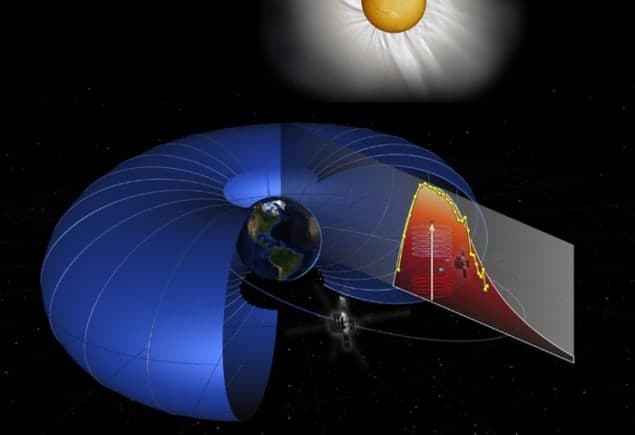
The debate surrounding how ultra-relativistic electrons trapped in the Earth’s Van Allen radiation belts are accelerated has finally been settled. Recent data from NASA’s Van Allen Probes mission suggest that the electrons are accelerated locally through wave–particle interactions, rather than by radial transport of electrons from outside the belts. The study clearly distinguishes between the two types of acceleration. Knowing where the acceleration occurs is essential to making more accurate space-weather predictions, as changes in the radiation belts can cause satellites in geostationary orbits to malfunction or breakdown.
The Van Allen radiation belts are two concentric, doughnut-shaped rings that are made up of high-energy electrons that vary in intensity. The belts are confined within the Earth’s magnetosphere and extend from about 1000 to 60,000 km above the Earth’s surface. Although discovered by American physicist James Van Allen more than 50 years ago, the Van Allen belts are not yet fully understood. According to the lead researcher of the new study, Geoffrey Reeves at the Los Alamos National Laboratory, New Mexico in the US, previous observational data taken in the 1990s did not fit the conventional theories of the time, leading researchers to question and debate over what processes really control the intensity of the radiation belts.
Capricious processes
For example, it was thought that all solar storms intensified the radiation belts but a study that Reeves and others carried out in 2003 showed that only half the storms intensified the belts. More surprisingly, they found that about a quarter of storms depleted the belts, making them less intense. Reeves says that the Van Allen Probes mission, launched on 30 August 2012, was designed specifically to fly straight through the belts and to discover which processes control how intense the belts are and how they change.
Previous theories suggested that two possible mechanisms were driving the electrons in the belts – local acceleration or radial acceleration. In radial acceleration, the electrons were thought to be transported perpendicular to the Earth’s magnetic field, from areas of low magnetic strength far from Earth to areas of high magnetic strength nearer Earth. This would cause acceleration as electrons being transported would speed up as the magnetic field strength increases. On the other hand, the local acceleration theory purports that low-energy electrons gain energy in situ, from a source at the heart of the belts.
Reeves told physicsworld.com that previous satellite missions had provided tantalizing evidence for local acceleration, but there were always limitations. “Essentially, neither side of the argument could convince the other side that local acceleration did or did not happen,” he says. He goes on to explain that Van Allen Probes have three features that make the latest observations unique, including “the right instruments spanning a broad range of energies with amazing sensitivity, an equatorial orbit that cuts through the belts at different altitudes and two satellites that can unambiguously resolve whether something is changing in time or in space or both”.
Rapid rise
On 9 October 2012 Reeves and his team observed a rapid energy increase in the energies of electrons in the belts that lasted for about 12 hours. If the acceleration was due to radial transport, the effects would first be measured further away from Earth and be seen moving inward. Instead, their measurements revealed an increase in electron energy that started in the middle of the belts and gradually spread both inward and outward, implying a local acceleration source.
Thanks to solar processes that affect the Earth’s magnetosphere and the belts, there is a peak in intensity of the belts. The local acceleration is produced thanks to resonant interaction of radiation-belt electrons with naturally occurring electromagnetic waves. If an electromagnetic wave spirals around the magnetic field at the same speed as that of an electron, the wave gives the electron a series of well-timed pushes that increase the electron’s speed. Once the electrons are accelerated locally they spread out (diffuse) both inward and outward but when electrons diffuse outward they lose energy. “So, diffusion still happens but it is not the cause of the acceleration,” says Reeves.
Electrons with these mega-electronvolt energies can easily penetrate satellites and their electronics, causing them to malfunction or fail completely. Knowing where these super-energetic electrons come from and what gives them their energy is a key step in predicting hazards to satellites, says Reeves. He feels that “there’s tonnes more exciting stuff to look at with the Van Allen Probes data”, some of which will be things that the satellites were designed to look for and some completely unexpected.
The research is published in Science 10.1126/science.1237743.



